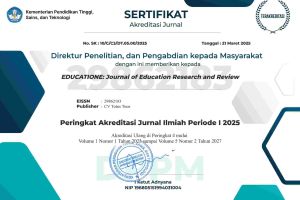SOCIAL PRESENCE THROUGH CULTURE: EMBEDDING MARUNG VALUES IN GROUP GUIDANCE AT A VOCATIONAL SCHOOL
DOI:
https://doi.org/10.59397/edu.v4i1.153Keywords:
ADDIE Model, Cultural Values, Group Guidance, Social Presence, Vocational EducationAbstract
Active peer interaction is essential for cognitive engagement, affective participation, and achievement in vocational education, yet field observations at SMK PGRI 5 Jember showed many students remained passive during group work, signaling weak social presence—the felt sense of being connected and “real” to others—which undermines collaboration, confidence, and learning quality. Leveraging the local Marung culture of togetherness, reciprocity, openness, equality, and empathy, this study designed, validated, and evaluated a culturally grounded group-guidance module to enhance students’ social presence. Using an R&D approach with the ADDIE model, the module underwent content and media expert validation and was tested via a one-group pretest–posttest quasi-experimental design. A 25-item Social Presence Questionnaire measured affective, interactive, and cohesive dimensions before and after the intervention; quantitative analysis employed the Wilcoxon Signed Rank Test and Cronbach’s alpha, and qualitative observations/reflections supplied contextual support. Results showed significant gains in social presence from a pre-test mean of 49.9% (low–moderate) to a post-test mean of 77% (high), p < .001; feasibility ratings were high (83–83.5%), and reliability was strong (α = .888), with observations confirming more balanced participation, respectful dialogue, empathy, and collaborative problem-solving. These findings indicate that integrating Marung values into structured guidance effectively fosters social presence, equitable participation, and empathic communication among vocational students. Theoretically, the work extends Social Presence Theory by demonstrating that culturally situated norms can strengthen interpersonal connectedness in face-to-face classrooms; practically, teachers and counselors can embed equitable turn-taking, respectful disagreement, and peer support into routine group learning, and policymakers can incorporate social-presence indicators into school climate assessments while allocating time for culturally informed guidance. Future research should replicate across multiple vocational schools with control/comparison groups, examine long-term effects on collaborative problem-solving, attendance, and well-being, and use mixed-method or experimental designs to clarify mechanisms linking Marung-based interaction norms to sustained engagement and academic outcomes.
Downloads
Published
How to Cite
Issue
Section
Citation Check
License
Copyright (c) 2025 EDUCATIONE

This work is licensed under a Creative Commons Attribution 4.0 International License.



















